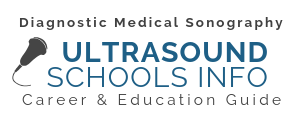A Closer Look at the Specialties Available in Diagnostic Medical Sonography

Author Samantha Callis, MHA, ACS, RDMS, RDCS, RVT
Diagnostic medical sonography refers to imaging organs and other structures inside a patient’s body using equipment that transmits high frequency sound waves. The ultrasound images obtained are used to detect and monitor medical conditions, abnormalities or diseases. Several cancers, such as testicular, prostate and breast, use ultrasounds as a crucial tool in diagnosis.
While most people connect ultrasounds with pregnancy, career opportunities within the various specialties are vast. Possible professional specialties include abdominal, small parts, cardiovascular, gynecologic, and musculoskeletal sonographic imaging.
Sonographers also work in many different locations, such as hospitals, doctor’s offices, medical/diagnostic labs, outpatient centers and other healthcare facilities.
Specialties in Sonography
Which Career Path is the Best Match for you?
The American Registry for Diagnostic Medical Sonography (ARDMS) offers five different specialty credentials in sonography, which correspond to a main exam and different specialty exams. There are also a variety of non-clinical career paths available to working sonographers.
| Credential Earned | Main Exam | Specialty Exam |
|---|---|---|
| RDMS | Sonography, Principles and Instrumentation (SPI) Exam |
|
| RDCS | Sonography, Principles and Instrumentation (SPI) Exam |
|
| RVT | Sonography, Principles and Instrumentation (SPI) Exam |
|
| RMSKS | Sonography, Principles and Instrumentation (SPI) Exam |
|
| Midwife Sonography Certificate | Midwife Sonographer Examination |
|
Obstetric and Gynecologic Sonography, OB/GYN
This is the function that most people probably think of when they hear the word “ultrasound”. An obstetric sonographer performs ultrasounds to determine the presence of a fetus inside the uterus of a woman and performs certain examinations to assess fetal well-being, anatomy, and growth. During the anatomy scan (sometimes called a 20-week scan), a sonographer may be able to visualize the fetal genitalia to determine the sex of the baby.
A diagnostic medical sonographer specializing in obstetric ultrasounds must possess the same foundational knowledge all sonographers require—a detailed understanding of anatomy, sonographic physics, and pathophysiology. Obstetric
sonographers must also be experienced with family-centered care as they are looking after two patients’ needs at once—mother and baby.
Gynecologic ultrasound involves performing diagnostic examinations of the female pelvic anatomy through transabdominal and transvaginal ultrasound methods. Transabdominal imaging provides an overview of the pelvis while transvaginal imaging provides higher resolution, detailed images of the pelvic organs. These ultrasounds are performed on the female reproductive system for reasons unrelated to pregnancy. Common indications a patient is in need of a gynecologic ultrasound include pelvic pain and abnormal bleeding. Gynecologic ultrasound can detect pathology, such as ovarian cysts and uterine fibroids. Ultrasound can even be used to guide procedures like the placement of an intrauterine device.
Cardiovascular and Vascular Technologists, RDCS
Cardiovascular technologists play a critical role in evaluating the heart and vascular system to assist doctors in managing the overall health of their patients.
Cardiac sonographers perform transthoracic echocardiograms. The transducer is placed in various locations on the chest and abdomen to evaluate heart structure and function in patients of all ages. They play an important role in procedures such as stress testing, transesophageal echocardiograms, and ultrasound guidance during several types of cardiac surgeries.
Common indications a patient may need a cardiac ultrasound completed include chest pain, murmurs, heart valve disease, heart attacks, etc. Sonographers working in cardiac ultrasound can further specialize, with appropriate training and credentials, into fetal and pediatric echocardiography. More recently, there is an Advanced Cardiac Sonographer (ACS) credential that is awarded to sonographers from Cardiovascular Credentialing International (CCI). Sonographers obtaining this credential have a breadth of experience, knowledge, and potential for career path advancement in echocardiography.
Vascular sonographers perform a wide variety of exams in the non-invasive vascular lab to evaluate the effectiveness of the peripheral circulatory system through evaluation of arteries and veins. Common examinations performed in the vascular lab include carotid duplex imaging, ankle brachial indices, lower extremity venous evaluation, and direct arterial imaging of peripheral arteries.
Physicians may order vascular evaluation on patients with indications like cerebrovascular accident (CVA) also called a stroke, or transient ischemic attacks (TIA) also called a mini stroke, uncontrolled diabetes, poor cardiac history, and other conditions that may be attributed to a vascular problem. Vascular sonography plays an important role in pre-operative and post- operative evaluation for patients undergoing surgical interventions such as dialysis fistula creation, bypass grafting for diseased native vessels, and endarterectomy.
The vascular sonographer also provides the interpreting physician with accurate diagnostic data. Sonographers generally perform non-invasive ultrasounds and assist physicians with making diagnoses based on the images they collect.
Breast Sonography, BR
The American Cancer Society estimates that about 281,000 new cases of invasive breast cancer will be diagnosed in women in 2021, resulting in 43,600 deaths. Breast ultrasounds can be more comprehensive than mammograms and are often performed to evaluate suspicious findings from the mammogram or from an abnormal physical exam.
Breast sonographers are highly skilled professionals trained in evaluating the normal and abnormal changes in breast tissue and surrounding areas. High frequency, high-resolution imaging transducers and machine settings are very important tools to help a breast sonographer detect subtle abnormalities and variations in breast tissue.
They work closely with radiologists and mammographers to thoroughly evaluate an area of suspicion. Many breast sonographers provide ultrasound guidance for physicians performing breast biopsies of suspected masses.
Abdominal Sonography, AB
Abdominal sonography involves performing ultrasound examinations of the organs and soft tissues in the abdominal region. This often includes evaluation of the liver, spleen, kidneys, pancreas, gallbladder, and biliary system. Abdominal ultrasound can help detect and diagnose a variety of conditions like gallstones, liver cirrhosis, pancreatic masses, and kidney stones. Indications for abdominal ultrasounds are broad, but commonly include reasons such as abdominal pain, abnormal laboratory testing, and nausea/vomiting.
Like other specialties of ultrasound, abdominal sonographers assist physicians in the performance of procedures such as biopsies of soft tissue structures and procedures to drain excess fluid from the abdomen (paracentesis) or chest (thoracentesis).
Musculoskeletal Sonography, MSKS
Musculoskeletal (MSK) sonography is a rapidly evolving specialty of ultrasound. The use of MSK sonography has increased in orthopaedic medicine, sports medicine, and rheumatology. MSK ultrasound evaluates muscles, connective tissues like ligaments and tendons, and nerves. MSK sonographers assist in the diagnosis of musculoskeletal injuries. Ultrasound can also be used to monitor musculoskeletal injury interventions like physical therapy, occupational therapy, orthopedic surgery, and other minimally invasive procedures such as steroid injections or nerve blocks.
Resources:
American Registry for Diagnostic Medical Sonography (ARDMS)
Society of Diagnostic Medical Sonography
American Cancer Society
March of Dimes



